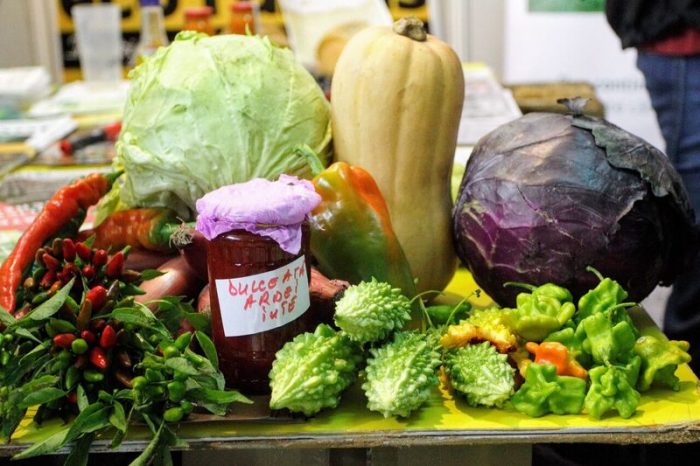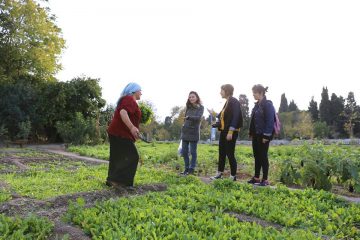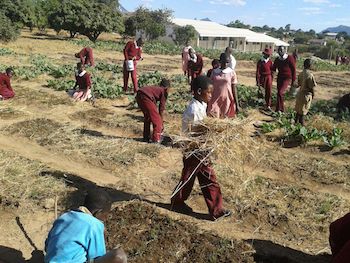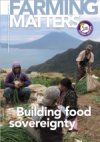Worldwide, the food sovereignty movement is taking root. The multitude of new food sovereignty initiatives speak to its strength as a concept, and as a source of practical responses to today’s problematic food and farming system. The stories in this issue of Farming Matters address interwoven issues of food sovereignty related to production, processing, trade and consumption. Together they highlight the value of tackling policy at multiple levels while at the same time taking practice into your own hands.

In the last 30 years, more and more people aredefending and promoting the right to control their own food, agriculture, livestock and fisheries systems, and the policies that affect those systems. ‘Food sovereignty’ is a term that encapsulates this these efforts, and that has catalysed these social movements. It entails people’s control of natural resources and markets, including access to land, seeds and water, as well as fair prices for small scale producers. Food sovereignty holds the wellbeing and local knowledge of producers and consumers at the centre of food practices and policy. Importantly, it stipulates the right to healthy and culturally appropriate food, and values environmentally respectful production practices.
Food sovereignty is fundamentally different from food security. Food security vouches for the provision of sufficient food to feed a population, and access to that food through market mechanisms. However, food security does not necessarily include a consideration for where food comes from, the quality or type of food, or the conditions under which it is produced and distributed, including aspects of human rights. Food sovereignty does.
A brief history of food sovereignty
The principle of food sovereignty was first launched by La Via Campesina – an international peasants movement – in 1996 during the FAO World Food Summit which took place in Rome. This occurred at the same time as the first global coordination of food producers and civil society organisations was created (called International Planning Committee for Food Sovereignty – IPC). In 2007, an alliance of social movements representing peasants and family farmers, artisanal fisher folk, indigenous peoples, landless peoples, rural workers, migrants, pastoralists, forest communities, women, youth, consumers, environmental and urban movements gathered in Mali to build a common understanding of food sovereignty, and to strengthen the global movement.
A matter of power

The importance of the global food sovereignty movement is growing as agribusiness gains economic and political power, and as industrial agriculture dominates world food produc-tion and consumption. This system has been support-ed and shaped by trade deals and international policy. Liberalised agricultural markets have benefited a small number of very large transnational companies who now dominate the supply of seeds, agrochemicals, processing, logistics and even food production. The mergers of Dow Chemical with DuPont, Syngenta with ChemChina, and if allowed, Monsanto with Bayer AG, will result in three companies controlling around 70% of the world’s agrochemicals and more than 60% of commercial seeds.
Everyday change
This concentration of power undermines the livelihoods of small scale farmers and producers across the supply chain, and moves those who do not farm ever further away from the sources of the food they eat. Industrialised food creates both a physical and a social distance between the consumer and the farmer. Nevertheless, as this issue of Farming Matters clearly demonstrates, change is occurring through the everyday practices and the powerful and diverse actions led by small scale food producers and (urban) citizens around the world.
Peasant farming versus industrial farming
Peasant and small scale agriculture is an integral part of food sovereignty and nutrition. According to the FAO, peasant agriculture provides around 70% of the food consumed globally, including the food consumed by the majority of those suffering from extreme hunger and malnutrition. Furthermore, it produces this food with just 30% of the resources and inputs used in agriculture. It uses around 20% of fossil fuels and 30% of water and is based on an enormous genetic diversity, using around 8000 livestock breeds and millions of plant varieties. Globally there are an estimated 1.5 billion peasant farmers, 800 million urban gardeners, 410 million people relying on forests or savannas as a primary source of food, 190 million pastoralists and over 100 million peasant fishers.
This is in stark contrast to industrial agriculture, which accounts for only 15% of the food that is traded internationally, but accounts for more than 80% of the fossil fuels and 70% of the water used in agriculture. It also uses a narrow genetic base of less than 100 livestock breeds and 150 plant specials. Nevertheless, the industrial agriculture sector benefits from the vast majority of funded research. 96% of all recorded food and agricultural research takes place in industrialised countries and 80% of that research is focused on industrial food processing and retailing.
Source: http://www.etcgroup.org/sites/www.etcgroup.org/files/web_who_will_feed_us_with_notes_0.pdf
More people around the world are starting to appreciate the role of food producers in society, and seek more direct relationships with them. Initiatives that support farmers’ markets, create community supported agriculture, seek the involvement of chefs and establish public purchasing arrangements are popping up everywhere. This issue describes several such experiences: for example how a fisherperson in the Faroes Islands organises to sell his fish directly to consumers , and how agricultural workers in Italy fight for dignified living and working conditions.
Food sovereignty in policy
Around the world, food sovereignty has been adopted as a political framework at the national level. In 2008, Ecuador was the first country to instate food sovereignty in its constitution, although its implementation is flawed. Since then, other countries have followed including Senegal, Mali, Bolivia, Nepal, Venezuela, and most recently Egypt (2014). As the first country on the European continent, Switzerland is on its way to bring food sovereignty into national legislation.

Important change is also happening in international policy making around food and farming. The Voluntary Guidelines on the Responsible Tenure of Land, Fisheries and Forests in the context of national food security is one such example. The food sovereignty movement, through the IPC, had a leading role in reforming the Committee on World Food Security (CFS). They did this by establishing the Civil Society Mechanism (CSM) in 2009 a unique, autonomous and self-organised space for inclusive civil society participation in global governance of food security and nutrition. The Declaration on the Rights of Peasant Men and Women and Other People Living in Rural Areas is another breakthrough as an international human rights instrument to protect peasant food production. After 15 years of work, the declaration is close to being adopted by the UN. While these are very important steps, the meaningful implementation and use of these policies and frame-works by (sub)national governments remains a challenge and will continue to need monitoring and pressure.
Grassroots responses
The great significance of food sovereignty as a concept is that it has been developed and driven by the organisations of peasants and small scale food producers. Because of this, it is a self-organised, grassroots response to the dynamics of the global food system. In this issue of Farming Matters we show how in Korea women’s groups are fighting to keep their own seed, in Zimbabwe schools are turning their yards into edible forests, and in Brazil farmers are working with nature aiming to live in an autonomous, sustainable way. The latter story is a good illustration of how agroecology is a means of reaching food sovereignty. In our special section on Europe we show how urban dwellers in Turkey are organising around local food in a violent context through a struggle to keep urban gardens alive, and how the food sovereignty movement in Eastern Europe is overturning supermarkets with food hubs and coops.
All these initiatives shorten food chains and create new alliances between producers and consumers. Moreover, these initiatives are founded on principles of environmental and social responsibility. Clearly people around the world are starting to understand the multiple benefits of adopting responsible food practices, forming a major force for change.
Adam Payne (adam@organiclea.org.uk) is a farmer and member of the Land Workers Alliance and Stanka Becheva (stanka.becheva@foeeurope.org) is food and agriculture campaigner for Friends of the Earth Europe.

